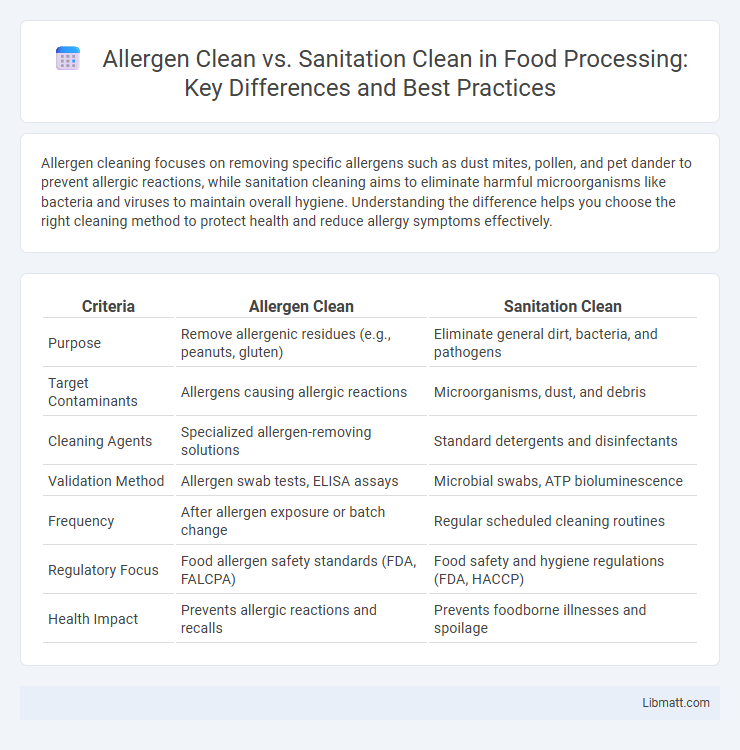Allergen cleaning focuses on removing specific allergens such as dust mites, pollen, and pet dander to prevent allergic reactions, while sanitation cleaning aims to eliminate harmful microorganisms like bacteria and viruses to maintain overall hygiene. Understanding the difference helps you choose the right cleaning method to protect health and reduce allergy symptoms effectively.
Table of Comparison
| Criteria | Allergen Clean | Sanitation Clean |
|---|---|---|
| Purpose | Remove allergenic residues (e.g., peanuts, gluten) | Eliminate general dirt, bacteria, and pathogens |
| Target Contaminants | Allergens causing allergic reactions | Microorganisms, dust, and debris |
| Cleaning Agents | Specialized allergen-removing solutions | Standard detergents and disinfectants |
| Validation Method | Allergen swab tests, ELISA assays | Microbial swabs, ATP bioluminescence |
| Frequency | After allergen exposure or batch change | Regular scheduled cleaning routines |
| Regulatory Focus | Food allergen safety standards (FDA, FALCPA) | Food safety and hygiene regulations (FDA, HACCP) |
| Health Impact | Prevents allergic reactions and recalls | Prevents foodborne illnesses and spoilage |
Understanding Allergen Clean vs. Sanitation Clean
Allergen clean targets the removal of food allergens such as nuts, gluten, and dairy proteins to prevent cross-contact and allergic reactions, primarily using specialized cleaning agents and thorough rinsing. Sanitation clean focuses on eliminating harmful microorganisms like bacteria, viruses, and fungi to reduce the risk of contamination and diseases, often requiring disinfectants and sanitizers that meet regulatory standards. Both processes are crucial in food processing environments but serve distinct purposes--one preventing allergen exposure and the other ensuring microbial safety.
Key Differences Between Allergen and Sanitation Cleaning
Allergen clean targets the removal of specific proteins that trigger allergic reactions, using specialized cleaning agents and techniques to eliminate allergens such as pollen, pet dander, and food residues. Sanitation clean focuses on reducing microbial contamination by killing or removing bacteria, viruses, and fungi to prevent illness and ensure overall hygiene. Your cleaning strategy should consider these key differences to effectively protect health and maintain a safe environment.
The Importance of Allergen Cleaning in Sensitive Environments
Allergen cleaning targets the removal of allergenic proteins such as peanut, gluten, and dairy residues to prevent cross-contact in sensitive environments like food production and healthcare facilities. Unlike general sanitation, which eliminates bacteria and viruses to reduce overall microbial load, allergen cleaning specifically reduces the risk of allergic reactions and ensures compliance with regulatory standards like the FDA Food Safety Modernization Act (FSMA). Your commitment to rigorous allergen cleaning protocols safeguards vulnerable individuals and maintains product integrity in allergen-sensitive settings.
Sanitation Cleaning: Focus on Pathogen and Bacteria Removal
Sanitation cleaning targets the effective removal of pathogens and bacteria to reduce the risk of contamination and illness. It involves using disinfectants and microbial control agents that eliminate harmful microorganisms on surfaces, ensuring a safer environment. Your facility's hygiene is enhanced by sanitation cleaning, which is critical in food processing, healthcare, and public spaces to maintain strict health standards.
Regulatory Standards for Allergen and Sanitation Cleaning
Regulatory standards for allergen clean and sanitation clean differ significantly, with allergen cleaning requiring adherence to strict protocols outlined by organizations like the FDA and the USDA to prevent cross-contact and ensure food safety. Sanitation cleaning follows guidelines such as those from the EPA and OSHA, emphasizing the removal of microbes, dirt, and residue to maintain hygiene. Your compliance with these regulatory standards is crucial to meet food safety regulations and avoid contamination risks.
Effective Allergen Cleaning Techniques and Protocols
Effective allergen cleaning techniques involve using specific detergents and cleaners designed to break down allergenic proteins on surfaces, ensuring thorough removal rather than just masking residues. Allergen cleaning protocols emphasize the use of dedicated equipment and microfiber cloths to prevent cross-contamination and maintain a safe environment for sensitive individuals. Your cleaning routine should prioritize verified allergen removal methods that comply with health standards to minimize allergic reactions effectively.
Common Misconceptions About Allergen vs. Sanitation Cleaning
Allergen cleaning targets the removal of specific proteins that cause allergic reactions, such as dust mite dander and pollen, whereas sanitation cleaning eliminates harmful microbes like bacteria and viruses to reduce infection risk. A common misconception is that sanitation alone ensures allergen-free surfaces, but allergens can persist without specialized cleaning agents and methods designed to neutralize them. Effective allergen control requires thorough vacuuming with HEPA filters and allergen-specific detergents, which differ fundamentally from general sanitation protocols aimed at microbial kill rates.
Tools and Products for Allergen vs. Sanitation Cleaning
Tools and products for allergen cleaning focus on removing specific allergenic proteins using specialized cleaners designed to target food residues such as peanuts, gluten, or dairy. Sanitation cleaning employs broader-spectrum disinfectants and detergents to eliminate bacteria, viruses, and general soil from surfaces, ensuring overall hygiene. Selecting the right products for your cleaning needs helps maintain both allergen safety and sanitary conditions effectively.
Allergen Control in Food Industry: Best Practices
Allergen control in the food industry requires dedicated allergen cleaning protocols that specifically target allergenic proteins rather than general sanitation cleaning, which aims to reduce microbial contamination. Allergen clean tools, procedures, and validated cleaning agents help prevent cross-contact and protect consumers with food allergies by removing residual allergenic contaminants effectively. Your facility's allergen control program should include routine allergen clean verification to ensure compliance with regulatory standards and minimize the risk of allergen-related recalls.
Choosing the Right Cleaning Approach for Your Facility
Choosing the right cleaning approach for your facility depends on its specific hygiene needs and industry regulations. Allergen clean targets the removal of allergenic proteins from surfaces to prevent cross-contact and protect sensitive individuals, making it essential in food production and healthcare settings. Sanitation clean focuses on reducing microbial load to acceptable levels, crucial for overall safety and compliance with health standards in restaurants, schools, and commercial facilities.
allergen clean vs sanitation clean Infographic

 libmatt.com
libmatt.com